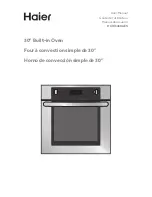
9
CONVECTION OVEN BAKING GUIDE
CONVECTION OVENS IN GENERAL
• Convection ovens constantly circulate air over the product. This strips away the thin layer of moisture laden air
from the top of the product allowing heat to penetrate more quickly. This allows cooking times to be shortened
and cooking temperatures reduced in convection ovens. Introducing steam into the cooking process prevents
the bake from loosing moisture and allows for a better product.
• Applying steam to dough during first 5 minutes, allows the yeast to work a little longer, allowing for better oven
spring and loaf volume keeping the outer layer flexible and moist. Once the outside layer of the dough sets,
gases in the loaf can no longer expand to increase the loaf size.
• Steaming the dough as it bakes also gelatinizes starch on the outside layer, producing a bread with a crisp crust
and a brown crust color in varying degrees; too much steam results in an undesirable crust. Steam also helps
to prevent wild breaks in the loaves because it delays the setting of the bread’s crust, allowing it more time to
bake and brown. However, in contrast, during the last stages of baking, a dry oven is required when the crust is
browning; after the steam is removed, the gelatinized layer dries out forming a thick crunchy crust.
• The convection oven is an electromechanical piece of equipment and is designed to produce a consistent re-
sult. Variations in results are therefore more likely due to differences in the preparation process.
BAKING HINTS
• Always maintain a consistent cooking process. Establish a process that works for you, write it down and stick
to it. Consistency in your cooking processes is very important to the quality of your bake.
• Always weigh your product. This will give you a more consistent size, color and quality.
• Do not overload pans or space product unevenly in the pan as this will create a uneven bake.
• Bent or warped pans can greatly affect the evenness of the bake.
• Always use the oven lights to view the product through the oven door windows. Do not open the oven doors
during baking as this will change the baking characteristics and produce erratic results.
• If using baker’s parchment, be sure the parchment does not blow over the product or obstruct air flow in any
way. This will create a uneven bake. Never use aluminum foil in your convection oven.
• Use proper sheet pans for baking. Aluminum pans have better heat transference than steel pans and
therefore yield much better bake results.
LOADING THE OVEN
• When loading the oven, stage products and racks so the oven doors are opened for the least amount of time
during the loading process to minimize the loss of heat inside the oven.
• Center each pan on the oven shelves. Spaces should be maintained equally between the pan edges and the
oven walls, front and back. This will allow for an even distribution of airflow. The better the air flow around the
product, the better and more consistent the bake.
• Load the pans on the shelves as close to equal distant apart as possible. Even vertical spacing of the pans on
shelves thru 3 or 4 inside the oven is important to the proper circulation of air and therefore will have an effect
on the quality of your bake.
• When loading the oven randomly, (Different times for different shelves) load the oven from the
center shelf out with even vertical spacing.
• When loading multiple pans at the same time, load the shelves spaced as equal distant as possible with
even vertical spacing.
UNLOADING THE OVEN
• Unload the top shelf before the bottom shelves. This is necessary because it is a characteristic of all
ovens that, after the fan shuts down, rising heat and the hot oven ceiling causes the top shelf to
bake quicker. This characteristic is more pronounced when baking at higher temperatures and/or for
prolonged periods of time.
• Always stage your product racks so that you can unload quickly with the door open for a
minimal amount of time. This is to preserve the temperature inside the oven cavity for your next round of
baking.
ALWAYS KEEP THE AREA NEAR THE UNIT FREE FROM COMBUSTIBLE MATERIALS.
KEEP FLOOR IN FRONT OF EQUIPMENT CLEAN AND DRY. IF SPILLS OCCUR,
CLEAN IMMEDIATELY TO AVOID THE DANGER OF SLIPS OF FALLS.
CAUTION
Summary of Contents for CCOF-4
Page 11: ......
Page 17: ...16 38 39 39 39 40 41 38 37 36 42 Detail A 35 43 MODEL CCOH 3 SK2268 Rev 8 1 07...
Page 19: ......










































